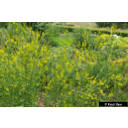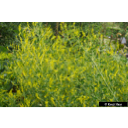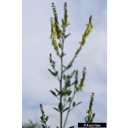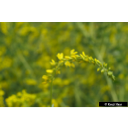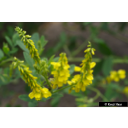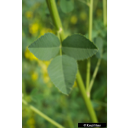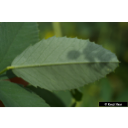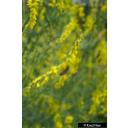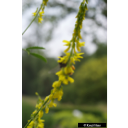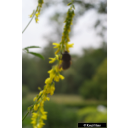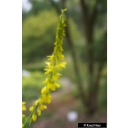Useful information about the taxon (species, subspecies, variety...)
Melilotus officinalis (L.) Lam. 1779
Fabaceae (Leguminosae, Papilionaceae)
(APG IV)Akzessionnummer: MArz-7126
Pflanzjahr: 0
Taxon concept: Euro+Med Plantbase
Melilotus officinalis (L.) Lam. - Accepted: Melilotus officinalis (L.) Lam. bei Zander 2008; Familie: Fabaceae (Leguminosae, Papilionaceae) (Zander 2008)Melilotus officinalis (L.) Lam. - Accepted: Melilotus officinalis (L.) Lam. bei Euro+Med Plantbase; Familie: Fabaceae (Leguminosae, Papilionaceae) (APG III)Melilotus officinalis (L.) Lam. - Unresolved: Melilotus officinalis (L.) Lam. bei The Plant List (2014), version 1.1; Familie: Fabaceae (Leguminosae, Papilionaceae) (APG III)Melilotus officinalis (L.) Lam. - Unresolved: Melilotus officinalis (L.) Lam. bei The Plant List (2014), version 1.1; Familie: Fabaceae (Leguminosae, Papilionaceae) (APG IV)Melilotus officinalis (L.) Lam. - Accepted: Melilotus officinalis (L.) Lam. bei Schmeil-Fitschen 2019; Familie: Fabaceae (Leguminosae, Papilionaceae) (APG IV)Melilotus officinalis (L.) Lam. - Accepted: Melilotus officinalis (L.) Lam. bei BfN Checklist Flora DE; Familie: Fabaceae (Leguminosae, Papilionaceae) (APG IV)Melilotus officinalis (L.) Lam. - Accepted: Melilotus officinalis (L.) Lam. bei World Flora Online - APG IV (Angiosperms); Familie: Fabaceae (Leguminosae) (World Flora Online - APG IV (Angiosperms))
- Color of flower
- yellow
- Life form
- herbaceous, terrestrial, biennial
BfN (2010): Artenfilter und Kartendienst für regionales gebietseigenes Saat- und Pflanzgut krautiger Arten, Accessed: 03.06.2025. See: https://regionalisierte-pflanzenproduktion.de/artenfilter.htm; Bundesamt für Naturschutz (BfN) (1999-2001 and ongoing): Floraweb - Daten und Informationen zu Wildpflanzen und zur Vegetation Deutschlands. www.floraweb.de.; Erhardt, W., Götz, E., Bödeker, N. & Seybold, S. (2008): Der große Zander. Enzyklopädie der Pflanzennamen. Band 2. Arten und Sorten. Eugen Ulmer KG, Stuttgart (Hohenheim), 18. Aufl., 2103 S.; Haider, M. et al. (2005): Wildbienenkataster. See: https://www.wildbienen-kataster.de; Jörn Breuer et al. (2023): Informationen zu ausgewählten ackerbaulichen Maßnahmen in FAKT II und im Rahmen der Öko-Regelungen bei den Direktzahlungen.. Landwirtschaftliches Technologiezentrum Augustenberg; Oberdorfer, E. (2001): Pflanzensoziologische Exkursionsflora. Für Deutschland und angrenzende Gebiete. Eugen Ulmer Verlag, Stuttgart, 8., stark überarb. u. erg. Aufl, 1056 S. 978-3-8001-3131-0.; Pritsch, Günter et al. (1985): Bienenweide.. Neumann-Neudamm, Melsungen; Pritsch, Günter et al. (2007): 200 Trachtpflanzen erkennen und bewerten.. Kosmos, Stuttgart; Schick, B. & Spürgin, A. (1997): Die Bienenweide. Eugen Ulmer Verlag, Stuttgart, Auflage: 4., völlig neubearb. u. erw. A., 216 S. 978-3800174188.; The International Plant Names Index (2009). Published on the Internet http://www.ipni.org; Courtesy to IPNI, 2009. Exported from IPNI at date: 2009-09-22 20:17:51; Westrich, P. et al. (2018): Die Wildbienen Deutschlands.. Ulmer Verlag ISBN 978-8186-0123-2.;
Diese Webseite verwendet Google Maps, um Karten und Standorte von Pflanzen in den Hohenheimer Gärten anzuzeigen. Dadurch werden unter Umständen Daten an Google weitergeleitet, was mit einer Verarbeitung Ihrer personenbezogenen Daten verbunden sein kann. Die Datenschutzerklärung von Google finden Sie hier: Datenschutzerklärung von Google

